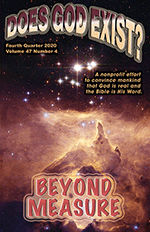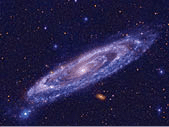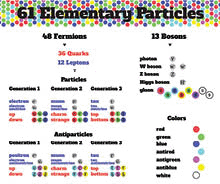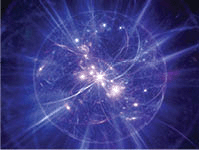Return to 4th Quarter 2020 articles.


Like many people, I have a routine that I follow to get my day started. My routine has both a spiritual and a physical component. I start the day by turning on my computer and going to NASA's Astronomy Picture of the Day (APOD.nasa.gov) website.
Our cover picture comes from that website on August 30, 2020. It shows nebula NGC6357 where stars are still forming. The brightest star you see above the gas cloud is Pismi 24-1 and it is more than 200 times the mass of our Sun. Hubble pictures have revealed that it is actually made up of three stars each 100 times our Sun's mass. Near the center of the picture, new stars seem to be breaking out of the cocoon.
I spend some time looking at the latest picture from space and reading the explanation of what the image shows and what is unique about it. This leads me to think about the creation and what the Creator did to make such a view possible.
It amazes me that the God who created the things we can see through our telescopes would bother with our little planet and with the likes of me. Why would a God who uses supernovas to produce the elements to make the world and my body care about me? How can I possibly be important enough to God that he “so loved the world, that he gave his only begotten Son, that whosoever believeth in him should not perish, but have everlasting life” (John 3:16 KJV)?

My training as a scientist also tells me not to accept every claim or explanation of what we see in the world around us. I thought I understood why there is such a thing as dark matter. I know that when things spin, centrifugal force throws matter away from the center. Because galaxies spin, the fundamental laws of physics tell me that they should fly apart. But they do not fly apart, meaning that some hidden force or energy is balancing the centrifugal force and holding them together. Calling it dark matter or dark energy makes sense because we cannot see whatever it is. As astronomers wrestle with this design and its cause, new pictures show that many galaxies do not have dark matter yet they somehow still seem to hold together. The latest count of galaxies of this kind is 324 that have either lost their dark matter or were created differently.

The nature of science is that no theory or explanation is so rigid or foolproof that it cannot be proven wrong or at least incomplete. Our understanding of even the most fundamental objects in space is limited and constantly changing. As I read scientific literature and books, I find more and more scientists in all fields talking about energies and forces outside of the familiar dimensions we study in basic science classes. Neutrinos, quarks, hyperons, antimatter, superstrings, baryons, muons, leptons, parallel universes, and more challenge our imaginations and tell us that what we see of the creation is very limited. Our three-dimensional world is just a small part of dimensions far beyond our own. Even though much of this cannot be tested or falsified, and thus is not a scientific fact, it does have a message for us. It challenges us to think beyond what our senses can reveal.
This leads me to another attempt to comprehend the nature of God. It is not an exercise in futility because the Bible approaches the question of what God is by listing his properties. That is a technique we use in science. We cannot see an electron, but we can understand it by studying its properties. We know an electron has a negative charge, that it spins clockwise in a north magnetic field, and that its mass is 1/1842 that of a proton. There are a whole plethora of properties of electrons that allow us to have a field of science known as chemistry, which helps us understand how molecules form.
My understanding of God is very similar to my understanding of an electron. The Bible uses the same technique to help us build our understanding of God. It tells us that God is not flesh and blood (Matthew 16:17) and that God is not a man (Numbers 23:19). The Bible also tells us that God cannot be seen by human eyes (1 John 4:12). We know that we are created in God's image (Genesis 1:27), but we also know that it is not our bodies that are in God's image but our spiritual makeup. John 4:24 tells us that God is a Spirit. It is clear that what separates us from the animal world is our creative capacity in art and music, our worship, our ability to feel guilt and sympathy, and our capacity to love unselfishly (1 John 4:8, 16). We know that God created time and the beginning and that he exists outside of time (Psalm 90:4; 102:27; 1 Corinthians 2:7; 2 Peter 3:8; Revelation 22:13).

Do I totally understand all there is to know about electrons because I know some of their properties? The answer is obviously “no.” Science has found particles that explain what causes charge and mass. I know enough about electrons to teach chemistry and to work on processes where the control of electrons is essential. I also know that there are dimensions beyond our own that give us a hint of a fuller understanding of electrons in the future. Scientists have never seen an electron, but they use the properties of electrons to create electronic equipment and understand chemical processes.
Do I understand all there is to know about God because I know some of his properties? Certainly not. But what I do know allows me to have confidence in praying to him and living my life in a way that reflects my understanding of God. I sense God's presence in those morning hours when I plan my day and talk to God about my concerns for those people and things I love.
One of the many things that science and the Bible agree on is the fact that our existence is not eternal. Built into the cosmos is the second law of thermodynamics, which tells us that the cosmos is moving toward a condition of disorder called entropy. As we watch stars and galaxies on the NASA site, we see that all stars die and take their planets with them. There is no doubt that the cosmos is not eternal.

The Bible agrees with this assessment, telling us that “The heavens will disappear with a roar; the elements will be destroyed by fire, and the earth and everything in it will be laid bare” (2 Peter 3:10 NIV 1984). Science cannot tell us anything about what happens to us when the three-dimensional world we live in is dissolved. The Bible assures us that time will end and that we will enter a dimension in which not only does time not exist, but all the negatives that depend on time will also cease to exist. There will be no more tears, sorrow, crying, or pain when our existence in this three-dimensional world ends.
Revelation 21 tells us there will be a new heaven and a new earth, and all things will be made new. In 1 Corinthians 15:40-57, Paul tells us that our bodies will be changed. Those verses also describe our present physical properties and the changes that will make all we endure here become a distant memory.

Picture credits:
Cover : https://apod.nasa.gov/apod/ap200830.html — NASA, ESA and Jesús Maíz Apellániz (IAA, Spain); Acknowledgement: Davide De Martin (ESA/Hubble)
© NASA images. Image from Big Stock.com
© Strangelet. Image from Big Stock.com
© maxxyustas. Image from Big Stock.com
© chaoss. Image from BigStock.com.
© denbelitsky. Image from Big Stock.com.
Scripture links/references are from BibleGateway.com. Unhighlighted scriptures can be looked up at their website.
